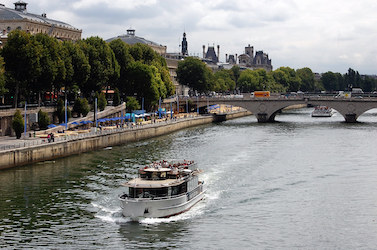
Seine River. The Seine is a 777-kilometre-long (483 mi) river in northern France. Its drainage basin is in the Paris Basin (a geological relative lowland) covering most of northern France. It rises at Source-Seine, 30 kilometers (19 mi) northwest of Dijon in northeastern France, flowing through Paris and into the English Channel at Le Havre.
Over 60% of its length, as far as Burgundy, is negotiable by large barges, and nearly its whole length is available for recreational boating; excursion boats offer sightseeing tours of the riverbanks in the capital city, Paris. The river is only 24 meters (79 ft) above sea level 446 kilometers (277 mi) from its mouth, making it slow flowing and thus easily navigable.
The average depth of the Seine today at Paris is about 9.5 meters (31 ft). Until locks were installed to raise the level in the 1800s, the river was much shallower within the city, and consisted of a small channel of continuous flow bordered by sandy banks (depicted in many illustrations of the period).
Today the depth is tightly controlled and the entire width of the river between the built-up banks on either side is normally filled with water. The average flow of the river is very low, only a few cubic meters per second, but much higher flows are possible during periods of heavy runoff.
There are 37 bridges in Paris across the Seine (the most famous of which are the Pont Alexandre III and the Pont Neuf) and dozens more outside the city
A very severe period of high water in January 1910 resulted in extensive flooding throughout the city of Paris. After a first-level flood alert in 2003, about 100,000 works of art were moved out of Paris, the largest relocation of art since World War II. Much of the art in Paris is kept in underground storage rooms that would have been flooded.
A 2002 report by the French government stated the worst-case Seine flood scenario would cost 10 billion euros and cut telephone service for a million Parisians, leaving 200,000 without electricity and 100,000 without gas.
In January 2018 the Seine again flooded, reaching a flood level of 5.84 metres (19 ft 2 in) on 29 January. The Deputy Mayor of Paris warned that the heavy rain was caused by climate change. He added that “We have to understand that climatic change is not a term, it’s a reality.”